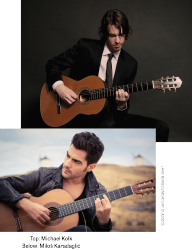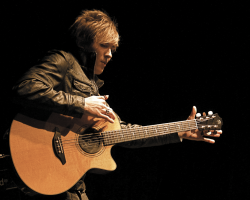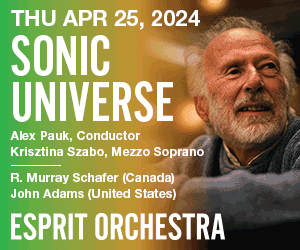 In mid-February David Perlman and I, along with a few dozen others, braved a bitterly cold Toronto winter evening to attend the Heliconian Hall launch of Mosaic, the second solo CD by the outstanding Toronto-based classical guitarist Michael Kolk.
In mid-February David Perlman and I, along with a few dozen others, braved a bitterly cold Toronto winter evening to attend the Heliconian Hall launch of Mosaic, the second solo CD by the outstanding Toronto-based classical guitarist Michael Kolk.
An hour or two later, having just witnessed as fine a display of classical guitar playing as either of us had ever seen, we found ourselves wondering: If an artist of Kolk’s world-class quality was launching a solo CD in such a small, intimate venue with 30 people attending, was the classical guitar, if not exactly on the solo concert instrument critically endangered or endangered lists, at least on the vulnerable list? Furthermore, in this age of downloading and ubiquitous social media, was the whole concept of venue even relevant any more?
For many years, through the 19th and early 20th centuries, music-making at home usually involved a piano; no self-respecting home would have been without one. Times and tastes change, however, and if there’s one single instrument more closely associated with amateur music-making than any other these days, it’s the guitar.
The instrument has been around for hundreds of years, of course, mainly in some form of what we think of as the classical or Spanish guitar, but it wasn’t until Segovia almost single-handedly established it as a bona fide solo recital instrument in the early 20th century that it really began to catch the general public’s attention. Electrical amplification of steel-string guitars in the 1930s and 1940s led to its increasing use in jazz and blues ensembles, but the real explosion in its popularity came in the late 1950s and early 1960s with its role in the folk-music revival and the pop-music revolution.
Suddenly, it seemed, every teenager wanted to play guitar, and it wasn’t too difficult to reach a basic level of chord and strumming proficiency that enabled you to enjoy yourself. “That’s a C-major chord. That’s a big one,” Mickey Shaughnessy tells an eagerly receptive Elvis Presley in 1957’s Jailhouse Rock; “Now try the G.”
What immediately set the guitar apart from other instruments, though, was its wide range of designs and sounds, and the variety of playing styles it offered. This variety and flexibility has always been part of the instrument’s wide appeal, and has helped to power it to its position as one of the most popular instruments in the world, particularly from an amateur participation viewpoint. Consider the numerous different types of guitar, and the playing possibilities they offer: classical; jazz; folk; rock; flamenco; pop; blues; country; heavy metal; bluegrass – just take your pick (no pun intended), and follow your fancy.
This variety has also made the issue of crossover performances – the current bane or lifesaver of classical music, depending on who’s doing it, how it’s done or how you happen to feel about it – essentially redundant for guitarists, who can at least to some extent move between genres quite freely. There are obviously technical as well as stylistic limitations here – I’ve played numerous theatrical runs of Man of La Mancha, for instance, but would never even consider trying to play Rent – but the blurring of boundaries between styles hardly raises eyebrows any more.
The Montenegrin guitarist Miloš Karadaglić certainly has no problems blurring the boundaries, not only between styles but also between venues. Now based in London in the UK after studying at the Royal Academy of Music, he exploded onto the international scene in 2011 with his debut Deutsche Grammophon CD Mediterráneo, which enjoyed worldwide success and earned him the Gramophone Young Artist of the Year award. His second CD, Latino, was released the following year, which also saw Miloš (no surname needed, apparently) touring Europe, North America, the Far East and Australia.
Canción, his third CD, and his latest release, Aranjuez, are both currently featured on our own Classical 96.3FM’s classical album charts, as indeed was Kolk’s Mosaic CD in the weeks following its release.
Karadaglić is clearly at home in any type of setting, from large concert halls to small nightclubs and non-traditional venues, yet apparently manages to keep the intimate nature of the instrument front and centre, albeit with the aid of some technical support. His debut in front of 3,000 people in London’s massive Royal Albert Hall prompted The Guardian to marvel at “the way a single guitarist, playing an intimate and understated set and equipped with a single microphone and some clever lighting, could shrink the Hall’s cavernous space into something so close.”
Part of this retention of a sense of intimacy is clearly Karadaglić’s strong reliance on the classical guitar repertoire (or at least its more popular works) which he combines with contemporary popular music – what one Australian newspaper described as “his ability to straddle both hardcore classical and pop classical camps.” His huge popularity may well also be helped by the fact that he’s not simply following the dumbed-down approach of some crossover artists but is maintaining an extremely high technical and musical standard.
We do perhaps tend to think of classical guitarists – or any solo concert artists, for that matter – as staying within their chosen field and playing nothing else, but in fact guitarists are frequently adept in several, and quite different, styles. Moreover, those who start with classical study would appear to have an advantage when it comes to moving to other styles of playing: not only is there the increased left and right hand finger dexterity compared to basic chord and strumming patterns, but there is also the undoubted benefit of being comfortable reading music. Not that that necessarily affects your playing ability – the list of guitarists who couldn’t read music includes Wes Montgomery, Jimi Hendrix, B. B. King, Eric Clapton, Django Reinhardt and Les Paul. You could be in worse company.
Take Michael Kolk, for example: it’s easy to regard him as a purely classical guitarist, but while completely understandable, it would be a mistake. Although he started with classical guitar at a very young age (“around six,” he thinks) and now has the classical technical and interpretive skills to match any player I’ve seen – and that includes Julian Bream, John Williams and Segovia – he didn’t restrict himself to playing classical guitar in his teens, teaching himself rock songs and viewing Eric Clapton, Jimmy Page and particularly Jimi Hendrix (“a revelation for me”) as influences.
The different styles certainly didn’t create a conflict, though. “While I loved rock music,” Kolk told me, “I always came back to classical guitar.” There were several reasons. He could play a complete piece of music without a band; practising alone was more fulfilling; there was more of a challenge in classical music; he was inspired by seeing his teacher play the pieces. And last but not least, “Classical guitar was different; I didn’t know anyone else at my school who played it, so I liked having that unique identity.”
Kolk has remained flexible ever since, often working with musicians from quite different backgrounds; moreover, he feels that this exploration of different styles of playing, together with learning to improvise and play electric guitar, has not only made him become more versatile but has also informed his classical playing. It has also made it more open-ended as a career; he admits that, depending on the opportunities that present themselves, he could end up going in other, completely different, directions in the future. “One thing I’ve learned,” he says, “ is that things never turn out exactly how you think, so I try to be open to opportunities and do what feels right and musically fulfilling at the time.”
He also notes that while there are more outstanding classical players now than ever before, there is probably a smaller audience – at least in the traditional concert attendance sense – than in the days when Segovia, Bream and Williams were touring. This is in part due to our ability to access music in so many different ways these days without ever leaving home, and it’s not just classical guitarists who are faced with the challenge of finding good performance opportunities, whatever the size of the venue.
Having the worldwide commercial exposure that Milós Karadaglić enjoys clearly makes that less of an issue, but surmounting that challenge at any level brings its own rewards, as it enables you to keep the personal connection and interaction through the music that is – for both performer and audience – such an essential and gratifying part of a live performance.
And that leads us back to the CD launch and the hugely appreciative but sparse audience of 30, although admittedly attendance was by invitation only. I had already received and played a review copy of the Mosaic CD before the launch event, and when we arrived I told David Perlman that I was eager to see if Michael Kolk was as astonishingly good live as he was on the CD. At the end of the evening, David turned to me and said “Well, now you’ll have to go back and see if he’s as good on the CD as he is live!”
The good news is that yes, he is.
The even better news is that the classical guitar is clearly alive and well, adapting to the challenges of contemporary performance and actually thriving on the various influences and different opportunities that may, at first sight, have seemed to present a growing threat.
With a player like Michael Kolk on our doorstep, the proof is there for all to hear.
You can hear Michael Kolk in a recital of music by Bach, Debussy, Barrios, Hétu and Gerhard at the Heliconian Hall, 35 Hazleton Avenue, Toronto, on Monday, June 23 at 8pm. Presented by Alma Records. Tickets are $20 at the door.
Milós Karadaglić will also be performing in Toronto this summer, giving a recital of music by Bach, Sor, Granados, Rodrigo and de Falla on Friday, August 8 at 7:30pm at Koerner Hall as part of the Toronto Summer Music Festival. Tickets start at $35.
Terry Robbins writes the Strings Attached column in the DISCoveries section of The WholeNote. He has played guitar in nearly 50 different Broadway musicals in community musical theatre productions in the GTA over the last 30 years.




